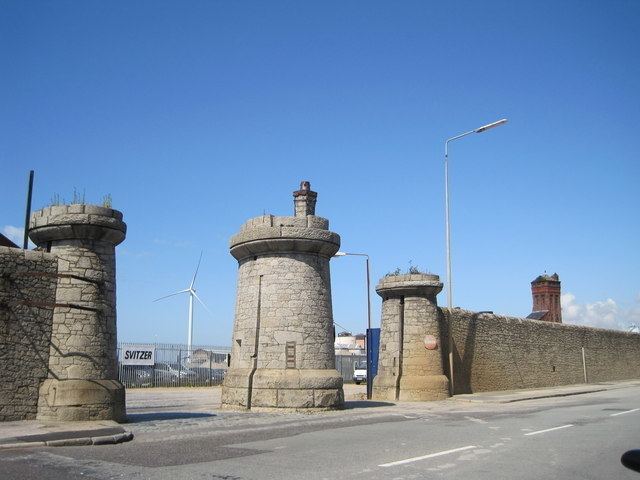OS grid SJ334924 Type Wet dock Owner The Peel Group | Closed 1988 Opened 4 August 1848 | |
 | ||
Joins Sandon Half Tide DockNelson Dock Similar Nelson Dock - Liverpool, Clarence Dock, Collingwood Dock, Stanley Dock, Trafalgar Dock | ||
Sound city 2015 highlights
Bramley-Moore Dock is a dock on the River Mersey, England, and part of the Port of Liverpool. It is situated in the northern dock system in Vauxhall, connected to Sandon Half Tide Dock to the north and Nelson Dock to the south. It was designed by Jesse Hartley and opened in 1848.
Contents
History
The dock was opened on 4 August 1848, as part of Hartley's major northern expansion scheme of that year, and was named after and opened by John Bramley-Moore, Chairman of the dock committee. When built, Bramley-Moore Dock was the most northerly part of the dock system. At the time, access to the River Mersey was from the south, through the new Nelson and Salisbury Docks, opened at the same time. When built, Bramley-Moore Dock was used for the largest steamships of the time, although this berthing was moved to Sandon Dock and Huskisson Dock within a few years.
In 1851, further docks were opened to the north. These included Wellington Half Tide Dock, which gave a new access between Bramley-Moore and the Mersey. Around 1900, this dock and the adjoining Sandon Dock were rebuilt, with the half tide dock now separate as Sandon Half Tide Dock, as it remains today.
Bramley-Moore was primarily a coal dock and so did not require extensive warehousing. This coal included both coal for export and also bunker coal for steamships, brought from the South Lancashire Coalfield. A high-level railway opened in 1857 to assist in bringing coal. The high-level railway was connected by viaduct to the Lancashire and Yorkshire Railway. The high-level railway was in use from 1856 to 1966.
After the decline in coal-fired steamships, the dock was still used to export coal. Following the Miners' Strike and the closure of coal mining in South Lancashire, and most of the UK, demand for the dock disappeared. It closed in 1988.
Bramley-Moore Dock was also the location of one of Liverpool's brick-built hydraulic accumulator towers. These provided hydraulic power to dock gates etc.
Since closure
In 2007, the Peel Group, owners of the Mersey Docks and Harbour Company, unveiled the £5.5 billion Liverpool Waters regeneration programme. Bramley-Moore Dock is encompassed in the 150-acre (0.61 km2) site.
Bramley-Moore Dock is the most northern of the docks within the Liverpool Maritime Mercantile City World Heritage Site and the planned Liverpool Waters. The hydraulic tower and dock retaining walls are Grade II listed buildings.
In 2015 and 2016, the dockland area was used for Liverpool Sound City. On 29 August 2016, the Mayor of Liverpool hinted that Everton F.C.'s new stadium would be built at the site.
At the Everton Football Club AGM on 4 January 2017 (the first AGM since Farhad Moshiri purchased a 49.9% stake in the club) shareholders were provided with an update on the search for a site for a new stadium. Everton FC CEO, Robert Elstone, was only able to report "solid" progress with Liverpool City Council and that the next couple of months will "be critical" in terms of securing a location. Moshiri has initiated an investigation into two brownfield sites within the city for suitability for a new ground, with plenty of speculation suggesting that a site at Bramley-Moore dock was preferred by the club over one at Stonebridge Cross on the outskirts in Croxteth. There was enough from both Everton FC Chairman, Bill Kenwright, and Liverpool Mayor, Joe Anderson, to tacitly confirm that the waterside location is the one Everton want but the latter admitted it is a complex issue.
